Rio Tinto apologises to traditional owners after blasting 46,000-year-old Aboriginal site
Mining giant detonated explosives at Juukan Gorge in Western Australia, destroying two ancient rock shelters
Australian Associated Press
Sun 31 May 2020 09.
Rio Tinto apologies for destroying Indigenous site 46,000 years old.
Photograph: PKKP Aboriginal Corporation/AFP/Getty Images
Mining giant Rio Tinto has apologised to traditional owners in Western Australia’s north after destroying a significant Indigenous site dating back 46,000 years, saying it is urgently reviewing plans for other sites in the area.
Rio detonated explosives in a part of the Juukan Gorge last Sunday, destroying two ancient rock shelters, which has devastated the Puutu Kunti Kurrama and Pinikura people.
The mining giant was granted approval for work at the Brockman 4 iron ore project in 2013, but subsequent archaeological excavation revealed ancient artefacts including grinding stones, a bone sharpened into a tool and 4000-year-old braided hair.
“We are sorry for the distress we have caused,” Rio Tinto Iron Ore chief executive Chris Salisbury said in a statement on Sunday.
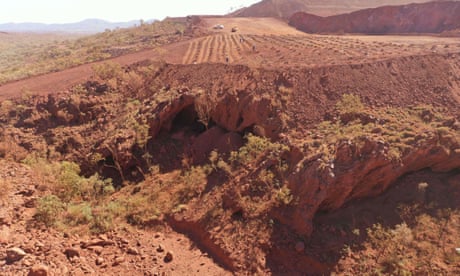
“Our relationship with the PKKP matters a lot to Rio Tinto, having worked together for many years.
“We will continue to work with the PKKP to learn from what has taken place and strengthen our partnership.
“As a matter of urgency, we are reviewing the plans of all other sites in the Juukan Gorge area.”
On Saturday, the Puutu Kunti Kurrama and Pinikura Aboriginal Corporation rejected Rio’s suggestion its representatives had failed to make clear concerns about preserving the site during years of consultation between the two parties.
Spokesman Burchell Hayes labelled the claim outrageous, saying Rio was told in October about the significance of the rock shelters and the company replied it had no plans to extend the Brockman 4 mine.
“The high significance of the site was further relayed to Rio Tinto by PKKPAC as recently as March,” Hayes said.
He said Rio did not advise of its intention to blast the area and the corporation “only found out by default on 15 May when we sought access to the area for NAIDOC Week in July”.
WA Aboriginal affairs minister Ben Wyatt has said he was unaware of the blast or concerns beforehand.
The state government hopes to pass its new Aboriginal cultural heritage bill this year, although Covid-19 has delayed the consultation process.
“It will provide for agreements between traditional owners and proponents to include a process to consider new information that may come to light, and allow the parties to be able to amend the agreements by mutual consent,” Wyatt said.
“The legislation will also provide options for appeal.”
Peter Stone, Unesco’s chair in cultural property protection and peace, said the archaeological destruction at Juukan Gorge was among the worst seen in recent history, likening it to the Taliban blowing up the Bamiyan Buddhas statues in Afghanistan and Isis annihilating sites in the Syrian city of Palmyra.
Rio said it was committed to updating its practices.
Mining giant Rio Tinto has apologised to traditional owners in Western Australia’s north after destroying a significant Indigenous site dating back 46,000 years, saying it is urgently reviewing plans for other sites in the area.
Rio detonated explosives in a part of the Juukan Gorge last Sunday, destroying two ancient rock shelters, which has devastated the Puutu Kunti Kurrama and Pinikura people.
The mining giant was granted approval for work at the Brockman 4 iron ore project in 2013, but subsequent archaeological excavation revealed ancient artefacts including grinding stones, a bone sharpened into a tool and 4000-year-old braided hair.
“We are sorry for the distress we have caused,” Rio Tinto Iron Ore chief executive Chris Salisbury said in a statement on Sunday.

“Our relationship with the PKKP matters a lot to Rio Tinto, having worked together for many years.
“We will continue to work with the PKKP to learn from what has taken place and strengthen our partnership.
“As a matter of urgency, we are reviewing the plans of all other sites in the Juukan Gorge area.”
On Saturday, the Puutu Kunti Kurrama and Pinikura Aboriginal Corporation rejected Rio’s suggestion its representatives had failed to make clear concerns about preserving the site during years of consultation between the two parties.
Spokesman Burchell Hayes labelled the claim outrageous, saying Rio was told in October about the significance of the rock shelters and the company replied it had no plans to extend the Brockman 4 mine.
“The high significance of the site was further relayed to Rio Tinto by PKKPAC as recently as March,” Hayes said.
He said Rio did not advise of its intention to blast the area and the corporation “only found out by default on 15 May when we sought access to the area for NAIDOC Week in July”.
WA Aboriginal affairs minister Ben Wyatt has said he was unaware of the blast or concerns beforehand.
The state government hopes to pass its new Aboriginal cultural heritage bill this year, although Covid-19 has delayed the consultation process.
“It will provide for agreements between traditional owners and proponents to include a process to consider new information that may come to light, and allow the parties to be able to amend the agreements by mutual consent,” Wyatt said.
“The legislation will also provide options for appeal.”
Peter Stone, Unesco’s chair in cultural property protection and peace, said the archaeological destruction at Juukan Gorge was among the worst seen in recent history, likening it to the Taliban blowing up the Bamiyan Buddhas statues in Afghanistan and Isis annihilating sites in the Syrian city of Palmyra.
Rio said it was committed to updating its practices.
Rio Tinto admits damaging Australian Aboriginal heritage site
Issued on: 27/05/2020

A photo taken by the PKKP Aboriginal Corporation on May 15 shows Juukan Gorge in Western Australia -- one of the earliest known sites occupied by Aboriginals in Australia -- that Rio Tinto has admitted damaging Handout PKKP Aboriginal Corporation/AFP
Sydney (AFP)
Anglo-Australian mining giant Rio Tinto has admitted damaging ancient Aboriginal rock shelters in the remote Pilbara region -- blasting near the 46,000-year-old heritage site to expand an iron ore mine.
Traditional owners said the culturally significant cave in Juukan Gorge, Western Australia -- one of the earliest known sites occupied by Aboriginals in Australia -- had been destroyed in a "devastating blow" to the community.
Explosives were detonated near the site on Sunday in line with state government approvals granted seven years ago, Rio Tinto said in a statement.
"In 2013, ministerial consent was granted to allow Rio Tinto to conduct activity at the Brockman 4 mine that would impact Juukan 1 and Juukan 2 rock shelters," the spokesperson said, adding the company had liaised with the Aboriginal community.
"Rio Tinto has worked constructively together with the PKKP people on a range of heritage matters under the agreement and has, where practicable, modified its operations to avoid heritage impacts and to protect places of cultural significance to the group."
Just one year after the blasting was approved, an archaeological dig at one of the shelters uncovered the oldest known example of bone tools in Australia -- a sharpened kangaroo bone dating back 28,000 years -- and a 4,000-year-old hair plait believed to have been worn as a belt.
DNA testing of the hair had shown a genetic link to the ancestors of indigenous people who still live in the area.
The 2014 excavations also found one of the oldest examples of a grinding stone ever found in Australia.
"There are less than a handful of known Aboriginal sites in Australia that are as old as this one", Puutu Kunti Kurrama Land Committee chair John Ashburton said, describing the site as one of the earliest-occupied locations nationally.
"Our people are deeply troubled and saddened by the destruction of these rock shelters and are grieving the loss of connection to our ancestors as well as our land.
The local Aboriginal corporation said traditional owners had first learned Rio Tinto planned to blast the gorge near the rock shelters on 15 May after requesting access to the site.
Attempts to negotiate with the mining company to stop the blast failed, the corporation said, and it received advice that the charges could not safely be removed or left undetonated.
"We recognise that Rio Tinto has complied with its legal obligations, but we are gravely concerned at the inflexibility of the regulatory system," Ashburton said.
"We are now working with Rio Tinto to safeguard the remaining rock shelters in the Juukan Gorge and ensure open communication between all stakeholders."
The Western Australia state government is currently reviewing the laws as part of a process that began in 2018.
© 2020 AFP

A sacred site showing 46,000 years of continual occupation and it's completely legal to blow it up

Sydney (AFP)
Anglo-Australian mining giant Rio Tinto has admitted damaging ancient Aboriginal rock shelters in the remote Pilbara region -- blasting near the 46,000-year-old heritage site to expand an iron ore mine.
Traditional owners said the culturally significant cave in Juukan Gorge, Western Australia -- one of the earliest known sites occupied by Aboriginals in Australia -- had been destroyed in a "devastating blow" to the community.
Explosives were detonated near the site on Sunday in line with state government approvals granted seven years ago, Rio Tinto said in a statement.
"In 2013, ministerial consent was granted to allow Rio Tinto to conduct activity at the Brockman 4 mine that would impact Juukan 1 and Juukan 2 rock shelters," the spokesperson said, adding the company had liaised with the Aboriginal community.
"Rio Tinto has worked constructively together with the PKKP people on a range of heritage matters under the agreement and has, where practicable, modified its operations to avoid heritage impacts and to protect places of cultural significance to the group."
Just one year after the blasting was approved, an archaeological dig at one of the shelters uncovered the oldest known example of bone tools in Australia -- a sharpened kangaroo bone dating back 28,000 years -- and a 4,000-year-old hair plait believed to have been worn as a belt.
DNA testing of the hair had shown a genetic link to the ancestors of indigenous people who still live in the area.
The 2014 excavations also found one of the oldest examples of a grinding stone ever found in Australia.
"There are less than a handful of known Aboriginal sites in Australia that are as old as this one", Puutu Kunti Kurrama Land Committee chair John Ashburton said, describing the site as one of the earliest-occupied locations nationally.
"Our people are deeply troubled and saddened by the destruction of these rock shelters and are grieving the loss of connection to our ancestors as well as our land.
The local Aboriginal corporation said traditional owners had first learned Rio Tinto planned to blast the gorge near the rock shelters on 15 May after requesting access to the site.
Attempts to negotiate with the mining company to stop the blast failed, the corporation said, and it received advice that the charges could not safely be removed or left undetonated.
"We recognise that Rio Tinto has complied with its legal obligations, but we are gravely concerned at the inflexibility of the regulatory system," Ashburton said.
"We are now working with Rio Tinto to safeguard the remaining rock shelters in the Juukan Gorge and ensure open communication between all stakeholders."
The Western Australia state government is currently reviewing the laws as part of a process that began in 2018.
© 2020 AFP

A sacred site showing 46,000 years of continual occupation and it's completely legal to blow it up

First Dog on the Moon
Destroyed by people who probably don’t know who their ancestors were 300 years ago
Rio Tinto blasts 46,000-year-old Aboriginal site to expand iron ore mine
Mining company was given permission to blast Juukan Gorge cave, which provided a 4,000-year-old genetic link to present-day traditional owners
Calla Wahlquist
Tue 26 May 2020 modified on Wed 27 May 2020
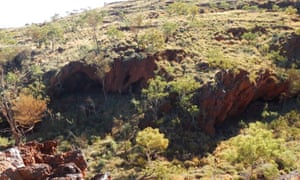
Most precious was a 4,000-year-old length of plaited human hair, woven together from strands from the heads of several different people, which DNA testing revealed were the direct ancestors of Puutu Kunti Kurrama and Pinikura traditional owners living today.
But the outdated Aboriginal Heritage Act does not allow for a consent to be renegotiated on the basis of new information. So despite regular meetings with Rio Tinto, the Puutu Kunti Kurrama and Pinikura (PKKP) Aboriginal Corporation was unable to stop the blast from going ahead.
“It’s one of the most sacred sites in the Pilbara region … we wanted to have that area protected,” PKKP director Burchell Hayes told Guardian Australia.
“It is precious to have something like that plaited hair, found on our country, and then have further testing link it back to the Kurrama people. It’s something to be proud of, but it’s also sad. Its resting place for 4,000 years is no longer there.”
Hayes said the site had been used as a campsite by Kurrama moving through the area, including in the memory of some elders.
“We want to do the same, we want to show the next generation,” he said. “Now, if this site has been destroyed, then we can tell them stories but we can’t show them photographs or take them out there to stand at the rock shelter and say: this is where your ancestors lived, starting 46,000 years ago.”
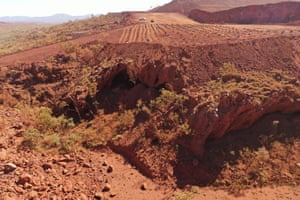
The cave in Juukan Gorge that was blasted. It is the only inland site in Australia to show signs of continual human occupation through the last Ice Age. Photograph: The Puutu Kunti Kurrama and Pinikura Aboriginal Corporation.
The Aboriginal Heritage Act has been up for review, in some form, since 2012. Draft legislation put forward by the former Liberal government in 2014 was rejected after even a National party MP argued it was unfair to traditional owners and did not allow for adequate consultation.
Re-writing the act was listed as a priority for Labor before their election win in 2017, and last month Aboriginal affairs minister Ben Wyatt pushed back the final consultation on his draft bill until later this year due to the coronavirus pandemic.
The new legislation will provide options to appeal or amend agreements to allow for the destruction of heritage sites, Wyatt said. He wasn’t aware of the risk to the Juukan site, or its destruction, until Monday.
“It will provide for agreements between traditional owners and proponents to include a process to consider new information that may come to light, and allow the parties to be able to amend the agreements by mutual consent,” he said. “The legislation will also provide options for appeal should either party not be compliant with the agreement.”
In its submission to the legislative review, Rio Tinto said it was broadly supportive of the proposed reform but that consent orders granted under the current system should be carried over, and that rights of appeal should be fixed, not broad or subject to extensions, lest it “prolong approvals or appeals processes at a critical point in the project.”
A spokesman from Rio Tinto said the company had a relationship with the Puutu Kunti Kurrama and Pinikura people dating back three decades, “and we have been working together in relation to the Juukan area over the past 17 years”.
“Rio Tinto has worked constructively together with the PKKP People on a range of heritage matters and has, where practicable, modified its operations to avoid heritage impacts and to protect places of cultural significance to the group,” the company said.
The mining company signed a native title agreement with the traditional owners in 2011, four years before their native title claim received formal assent by the federal court. They facilitated the salvage dig in 2014, which uncovered the true age of the site.
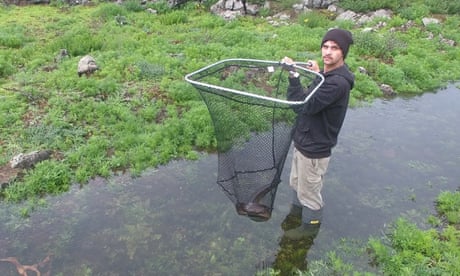
Budj Bim Indigenous eel trap site added to world heritage list
https://www.theguardian.com/australia-news/2019/jul/07/budj-bim-indigenous-eel-trap-site-added-to-world-heritage-list
Archeologist Dr Michael Slack, who led that dig, said it was a once-in-a-lifetime discovery.
An earlier 1 metre test dig, conducted in 2008, dated the site at about 20,000 years old, but the salvage expedition uncovered a “very significant site” with more than 7,000 artefacts collected, including grid stones that were 40,000 years old, thousands of bones from middens which showed changes in fauna as the climate changed, and sacred objects.
The flat floor of the cave allowed for a significant depth of soil and sand to build up, creating a layer almost two metres deep in parts. Most archeological digs in the Pilbara hit rock at 30cm.
Most significantly, the archeological records did not disappear during the last Ice Age. Most inland archeological sites in Australia show that people moved away during the Ice Age between 23,000 and 19,000 years ago, as the country dried up and water sources dried up. Archeological evidence from Juukan Gorge suggest it was occupied throughout.
“It was the sort of site you do not get very often, you could have worked there for years,” he said. “How significant does something have to be, to be valued by wider society?” he said.
• This article was amended on 27 May 2020 to correct the spelling of Burchell Hayes.
Destroyed by people who probably don’t know who their ancestors were 300 years ago
Rio Tinto blasts 46,000-year-old Aboriginal site to expand iron ore mine
Mining company was given permission to blast Juukan Gorge cave, which provided a 4,000-year-old genetic link to present-day traditional owners
Calla Wahlquist
Tue 26 May 2020 modified on Wed 27 May 2020

This cave in the Juukan Gorge, dubbed Juukan 2, was destroyed in a mining blast on Sunday. Consent was given through outdated Aboriginal heritage laws drafted in 1972. Photograph: The Puutu Kunti Kurrama and Pinikura Aboriginal Corporation.
A sacred site in Western Australia that showed 46,000 years of continual occupation and provided a 4,000-year-old genetic link to present-day traditional owners has been destroyed in the expansion of an iron ore mine.
The cave in Juukan Gorge in the Hammersley Ranges, about 60km from Mt Tom Price, is one of the oldest in the western Pilbara region and the only inland site in Australia to show signs of continual human occupation through the last Ice Age. It was blasted along with another sacred site on Sunday.
Mining company Rio Tinto received ministerial consent to destroy or damage the site in 2013 under WA’s outdated Aboriginal heritage laws, which were drafted in 1972 to favour mining proponents.
One year after consent was granted, an archeological dig intended to salvage whatever could be saved discovered the site was more than twice as old as previously thought and rich in artefacts, including sacred objects.
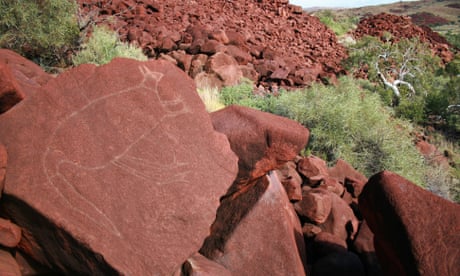
Australia lodges world heritage submission for 50,000-year-old Burrup Peninsula rock art
https://www.theguardian.com/artanddesign/2020/jan/29/australia-lodges-world-heritage-submission-for-50000-year-old-burrup-peninsula-rock-art
A sacred site in Western Australia that showed 46,000 years of continual occupation and provided a 4,000-year-old genetic link to present-day traditional owners has been destroyed in the expansion of an iron ore mine.
The cave in Juukan Gorge in the Hammersley Ranges, about 60km from Mt Tom Price, is one of the oldest in the western Pilbara region and the only inland site in Australia to show signs of continual human occupation through the last Ice Age. It was blasted along with another sacred site on Sunday.
Mining company Rio Tinto received ministerial consent to destroy or damage the site in 2013 under WA’s outdated Aboriginal heritage laws, which were drafted in 1972 to favour mining proponents.
One year after consent was granted, an archeological dig intended to salvage whatever could be saved discovered the site was more than twice as old as previously thought and rich in artefacts, including sacred objects.

Australia lodges world heritage submission for 50,000-year-old Burrup Peninsula rock art
https://www.theguardian.com/artanddesign/2020/jan/29/australia-lodges-world-heritage-submission-for-50000-year-old-burrup-peninsula-rock-art
Most precious was a 4,000-year-old length of plaited human hair, woven together from strands from the heads of several different people, which DNA testing revealed were the direct ancestors of Puutu Kunti Kurrama and Pinikura traditional owners living today.
But the outdated Aboriginal Heritage Act does not allow for a consent to be renegotiated on the basis of new information. So despite regular meetings with Rio Tinto, the Puutu Kunti Kurrama and Pinikura (PKKP) Aboriginal Corporation was unable to stop the blast from going ahead.
“It’s one of the most sacred sites in the Pilbara region … we wanted to have that area protected,” PKKP director Burchell Hayes told Guardian Australia.
“It is precious to have something like that plaited hair, found on our country, and then have further testing link it back to the Kurrama people. It’s something to be proud of, but it’s also sad. Its resting place for 4,000 years is no longer there.”
Hayes said the site had been used as a campsite by Kurrama moving through the area, including in the memory of some elders.
“We want to do the same, we want to show the next generation,” he said. “Now, if this site has been destroyed, then we can tell them stories but we can’t show them photographs or take them out there to stand at the rock shelter and say: this is where your ancestors lived, starting 46,000 years ago.”

The cave in Juukan Gorge that was blasted. It is the only inland site in Australia to show signs of continual human occupation through the last Ice Age. Photograph: The Puutu Kunti Kurrama and Pinikura Aboriginal Corporation.
The Aboriginal Heritage Act has been up for review, in some form, since 2012. Draft legislation put forward by the former Liberal government in 2014 was rejected after even a National party MP argued it was unfair to traditional owners and did not allow for adequate consultation.
Re-writing the act was listed as a priority for Labor before their election win in 2017, and last month Aboriginal affairs minister Ben Wyatt pushed back the final consultation on his draft bill until later this year due to the coronavirus pandemic.
The new legislation will provide options to appeal or amend agreements to allow for the destruction of heritage sites, Wyatt said. He wasn’t aware of the risk to the Juukan site, or its destruction, until Monday.
“It will provide for agreements between traditional owners and proponents to include a process to consider new information that may come to light, and allow the parties to be able to amend the agreements by mutual consent,” he said. “The legislation will also provide options for appeal should either party not be compliant with the agreement.”
In its submission to the legislative review, Rio Tinto said it was broadly supportive of the proposed reform but that consent orders granted under the current system should be carried over, and that rights of appeal should be fixed, not broad or subject to extensions, lest it “prolong approvals or appeals processes at a critical point in the project.”
A spokesman from Rio Tinto said the company had a relationship with the Puutu Kunti Kurrama and Pinikura people dating back three decades, “and we have been working together in relation to the Juukan area over the past 17 years”.
“Rio Tinto has worked constructively together with the PKKP People on a range of heritage matters and has, where practicable, modified its operations to avoid heritage impacts and to protect places of cultural significance to the group,” the company said.
The mining company signed a native title agreement with the traditional owners in 2011, four years before their native title claim received formal assent by the federal court. They facilitated the salvage dig in 2014, which uncovered the true age of the site.

Budj Bim Indigenous eel trap site added to world heritage list
https://www.theguardian.com/australia-news/2019/jul/07/budj-bim-indigenous-eel-trap-site-added-to-world-heritage-list
Archeologist Dr Michael Slack, who led that dig, said it was a once-in-a-lifetime discovery.
An earlier 1 metre test dig, conducted in 2008, dated the site at about 20,000 years old, but the salvage expedition uncovered a “very significant site” with more than 7,000 artefacts collected, including grid stones that were 40,000 years old, thousands of bones from middens which showed changes in fauna as the climate changed, and sacred objects.
The flat floor of the cave allowed for a significant depth of soil and sand to build up, creating a layer almost two metres deep in parts. Most archeological digs in the Pilbara hit rock at 30cm.
Most significantly, the archeological records did not disappear during the last Ice Age. Most inland archeological sites in Australia show that people moved away during the Ice Age between 23,000 and 19,000 years ago, as the country dried up and water sources dried up. Archeological evidence from Juukan Gorge suggest it was occupied throughout.
“It was the sort of site you do not get very often, you could have worked there for years,” he said. “How significant does something have to be, to be valued by wider society?” he said.
• This article was amended on 27 May 2020 to correct the spelling of Burchell Hayes.

No comments:
Post a Comment